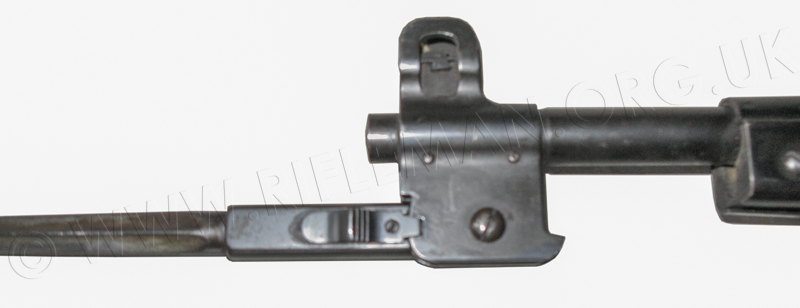
Please be aware that some specialist imagery may take time to load.
This site is designed for dedicated researchers on desktop or tablet, not ideal for mobile browsing.
Unlike the equivalent experimental conversion of a P'14 rifle by the Soley Armament Company,
to include an integral bayonet, which rifle was engineered to appear more like the S.M.L.E. (Rifle, Short, Magazine Lee-Enfield),
this Birmingham Small Arms Company example made little attempt to alter the appearance of the parent rifle
In the mid 1930s, during the same period in which the Royal Small Arms Factory
was working on the probable new British Service Rifle, the Lee-Enfield No.1 Mk. VI (later to become the No.4 Rifle),
the B.S.A. Company produced a design for a new weapon.
This was in the form of an Enfield Rifle No.3, better known as the Pattern '14, converted to include an integral bayonet.
N.B. The photographs on this page are by kind permission of the Officer Commanding
the Warminster Small Arms School Collection
and remain copyright to both the S.A.S.C and www.rifleman.org.uk.
The markings on the rifle are almost understated, being simply the words
"CONVERSION BY B.S.A. GUNS"
engraved on the left-hand-side of the rear-sight protecting wings,
and an inspection mark ahead of the bolt release catch.

As might be expected, the rifle showed no difference in appearance from the issue P'14 aft of the barrel band;
From a distance, not much alteration was evident other than
those additions beneath the exposed part of the barrel and muzzle.

The barrel was fitted with a one-piece replacement fore-sight unit that included a pivot for the fold-under bayonet.
The release catch was part of the swivelling bayonet, and locked into an indent under the rear of the fore-sight fitting.
Apart from the bayonet itself, the other unusual modification was the replacement of the upper forward hand-guard wood
with a perforated steel cooling casing, presumably to protect a hand that would need to be in that position for bayonet fighting, while adding strength to the fore-end.

When the bayonet was extended, the same lug locked into an equivalent indent at the front of the fore-sight unit.

The bayonet's blade is clearly a modification of the early design of what is colloquially known as the "pig sticker",
in its original and now quite rare cruciform configuration.

When not in use, the bayonet is folded neatly out of the way into the underside of the lower front hand-guard wood furniture.
Note that a new design of nose-cap has been required to accomodate both this and the front fixing of the cooling casing above.

The butt has had the butt-disk removed, and a simple hand-written label identifies the rifle as
"RIFLE EXP
BRITISH
No 190313"
as part of the Warminster Small Arms School collection.

Another contemporary experimental rifle, to be found at Warminster in the Small Arms School Collection, is fitted with a prototype bayonet
assumed to be of a design mooted for the new 'long rifle'.
This is affixed to an SMLE-like nose-cap from which the barrel protrudes about 3/4".
The rifle to which the bayonet is attached is labelled as
the "Lee-Enfield No.3 Pattern '14 - Shortened Experimental Model"- with folding bayonet".
This is understood to fold back underneath the fore-end
by being spun laterally.

See another fascinating Enfield conversion;
An experimental S.M.L.E. configured for Anti-aircraft use.
and view this associated flip-page facsimile of
Provisional Notes on Firing at Aircraft with Machine Guns and other Small Arms - 1917
See also: an equivalent to this page's experimental P'14 rifle conversion with an integral bayonet, by the Soley Armament Company.
The Lee-Enfield Rifle No.1 Mk.VI
and the Enfield Trials Pattern 1913 Rifle.
View an extremely rare British WW1/II sniper version of the P'17 rifle
and read a fascinating contemporary insight into the birth of the .30-06 calibre 'American Enfield' Pattern '17 Rifle
Return to: TOP of PAGE
See this website's Raison d'être